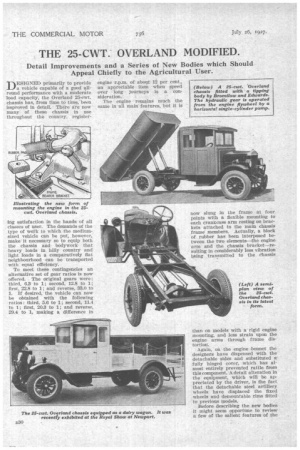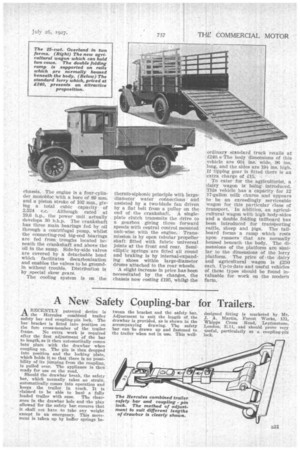, THE 25-CWT. OVERLAND MODIFIED.
Page 48

Page 49

If you've noticed an error in this article please click here to report it so we can fix it.
Detail Improvements and a Series of New Bodies which Should Appeal Chiefly to the Agricultural User.
iTht ESIGNED primarily to provide -1-1 a vehicle capable of a good allround performance with a moderate load capacity, the Overland 25-ewt. chassis has, from time to time, been improved in detail. There are now many of these chassis in use throughout the country, register
ing satisfaction in the hands of all classes of user. The demands of the type of work to which the mediumsized vehicle can be put, however, make it necessary so to equip both the chassis and bodywork that heavy loads in hilly country and light loads in a comparatively flat neighbourhood can be transported with equal efficiency.
To meet these contingencies an alternative set of gear ratios Is now offered. The original gears were: third, 6.3 to 1; second, 12.8 to 1; first, 22.8 to 1; and reverse, 33.0 to 1. If desired, the vehicle can now be obtained with the following ratios: third, 5.6 to 1; second, 11.4 to 1; first, 20.3 to 1; and reverse, 29.4 to 1, making a difference in engine r.p.m. of about 12 per cent., an appreciable item when peed over long journeys is a consideration.
The engine remains much the same in all main features, but it is
now slung in the frame at four points with a flexible mounting to each crankcase arm resting on brackets attached to the main chassis frame members. Actually, a block of rubber has been interposed between the two elements—the engine arm and the chassis bracket—resulting in considerably less vibration bOng transmitted to the chassis
than on models with a rigid engine Mounting, and less strain upon the engine arms through frame distortion.
Again, on the engine bonnet the designers have dispensed with the detachable sides and substituted afully hinged cover, which has almost entirely prevented rattle from this component. A detail alteration in the equipment, which will be appreciated by the driver, is the fact that the detachable steel artillery wheels have displaced the fixed wheels and demountable rims fitted to previous models.
Before describing the new bodies it might seem opportune to review a few of the salient features of the chassis. The engine is a four-cylinder monobloc with a bore of 89 ram. and a piston stroke of 102 mm., giving a total cubic capacity of 2524 c.c. Although rated at 19.6 h.p., the power unit actually develops 30 b.h.p. The crankshaft has three main bearings fed by oil through a centrifugal purap, whilst the connecting-rod big-end bearings are fed from troughs located beneath the crankshaft and above the oil in the sump. Side-by-side valves are covered by a detachable head which facilitates decarbonization and enables the valves to be groundin without trouble. Distribution is by special skew gears.
The cooling system is on the thernio-siphonic principle with largediameter water connections and assisted by a two-blade fan driven by a flat belt from a pulley on the end of the crankshaft. A singleplate clutch transmits the drive to a gearbox giving three forward speeds with central control mounted unit-wise with the engine. Transmission is by open tubular propeller shaft fitted with fabric universal joints at the front and rear. Semielliptic springs are fitted all round and braking is by internal-expanding shoes within large-diameter drums attached to the rear wheels.
A slight increase in price has been necessitated by the changes, the chassis now costing f195, whilgt, the ordinary standard truck retails at 240. o The body dimensions of this vehicle are 60A ins. wide, 96 ins. long, and the sides are 19iins. high. If tipping gear is fitted there is an extra charge of £15.
To cater for the agriculturist, a dairy wagon is being introduced. This vehicle has a capacity for 12 17-gallon milk churns and appears to be an exceedingly serviceable wagon for this particular class of transport. In addition, an agriculcultural wagon with high body-aides and a double folding tailboard has been iutroduced for transporting cattle, sheep and pigs. The tailboard forms a ramp which rests upon runners that are normally housed beneath the body. The dimensions of the platform are similar to the dimensions of the lorry. platform. The price of the dairy and agricultural wagon is f 250 each. Up-to-date and useful vehicles of these types should be found invaluable for work on the modern farm.




































































































